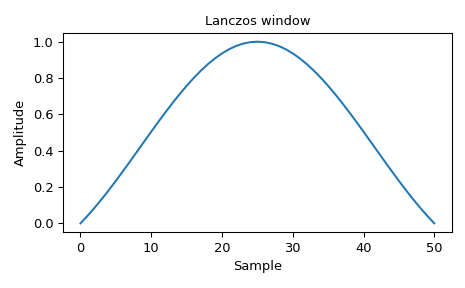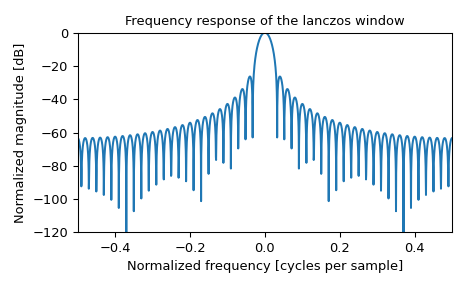scipy.signal.windows.lanczos#
- scipy.signal.windows.lanczos(M, *, sym=True)[source]#
Return a Lanczos window also known as a sinc window.
- Parameters:
- Mint
Number of points in the output window. If zero, an empty array is returned. An exception is thrown when it is negative.
- symbool, optional
When True (default), generates a symmetric window, for use in filter design. When False, generates a periodic window, for use in spectral analysis.
- Returns:
- wndarray
The window, with the maximum value normalized to 1 (though the value 1 does not appear if M is even and sym is True).
Notes
The Lanczos window is defined as
\[w(n) = sinc \left( \frac{2n}{M - 1} - 1 \right)\]where
\[sinc(x) = \frac{\sin(\pi x)}{\pi x}\]The Lanczos window has reduced Gibbs oscillations and is widely used for filtering climate timeseries with good properties in the physical and spectral domains.
New in version 1.10.
References
[1]Lanczos, C., and Teichmann, T. (1957). Applied analysis. Physics Today, 10, 44.
[2]Duchon C. E. (1979) Lanczos Filtering in One and Two Dimensions. Journal of Applied Meteorology, Vol 18, pp 1016-1022.
[3]Thomson, R. E. and Emery, W. J. (2014) Data Analysis Methods in Physical Oceanography (Third Edition), Elsevier, pp 593-637.
[4]Wikipedia, “Window function”, http://en.wikipedia.org/wiki/Window_function
Examples
Plot the window
>>> import numpy as np >>> from scipy.signal.windows import lanczos >>> from scipy.fft import fft, fftshift >>> import matplotlib.pyplot as plt >>> fig, ax = plt.subplots(1) >>> window = lanczos(51) >>> ax.plot(window) >>> ax.set_title("Lanczos window") >>> ax.set_ylabel("Amplitude") >>> ax.set_xlabel("Sample") >>> fig.tight_layout() >>> plt.show()

and its frequency response:
>>> fig, ax = plt.subplots(1) >>> A = fft(window, 2048) / (len(window)/2.0) >>> freq = np.linspace(-0.5, 0.5, len(A)) >>> response = 20 * np.log10(np.abs(fftshift(A / abs(A).max()))) >>> ax.plot(freq, response) >>> ax.set_xlim(-0.5, 0.5) >>> ax.set_ylim(-120, 0) >>> ax.set_title("Frequency response of the lanczos window") >>> ax.set_ylabel("Normalized magnitude [dB]") >>> ax.set_xlabel("Normalized frequency [cycles per sample]") >>> fig.tight_layout() >>> plt.show()
